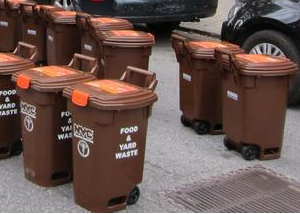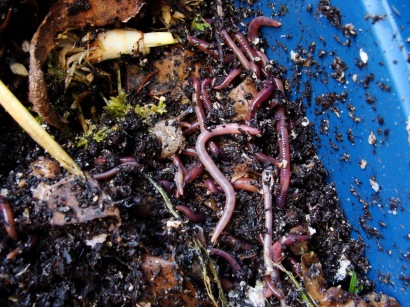Hey have you taken my survey on recycling yet… https://www.surveymonkey.com/r/3GTHQJY
In my last post (Composting 101) I wrote a general overview of composting. I figured it would be helpful to read my [ before this post, so if you haven’t already read it why not give it a read before you come back to read this post? Today, I am going to be talking about the implementation of composting throughout NYC by the Department of Sanitation’s composting department.

Do these brown and orange trash cans look familiar? If they do, that’s probably because your neighborhood was selected for a ‘trial run’ of the NYC Composting Project; for the time being the collection is only offered in particular neighborhoods.

A map designating areas that collection is available.
I am also providing a link to a PDF where you can find out if your neighborhood is eligible : http://www1.nyc.gov/assets/dsny/docs/nyc-organics-collection-areas.pdf
According to the Department of Sanitation they are offering this service because,”Organic waste accounts for about 31% of all waste generated by residents in New York City. Organic waste includes yard waste, food scraps, compostable paper (napkins, paper plates, etc.), and other materials suitable for industrial-scale composting.
Operating a curbside program helps NYC reduce waste sent to costly landfills, deters pests by storing food waste in special rodent-resistant bins, and creates compost (a natural soil amendment) or renewable energy.”
So the Department of Sanitation is being proactive, but they are really starting to get things done. New NYC composting rules are forcing hotels, restaurants, sports arenas and food wholesalers to recycle their food waste. If any of the businesses mentioned above meet this criteria they are required to recycle or else they will be fined anywhere from $250 upward to $1,000. The requirements are as follows: hotels will at least 150 rooms, stadiums with 15,000 or more seats and large food-processing plants.
According to an article published in the Daily News, “The rules will require businesses to separate their food waste from other trash and recycling and hire a carting company to compost or reuse it. They will also have the option to compost themselves on site.”

You can receive compost produced by the DSNY.







 I hope you learned something new by reading this post, my next post will be about composting in NYC.
I hope you learned something new by reading this post, my next post will be about composting in NYC.